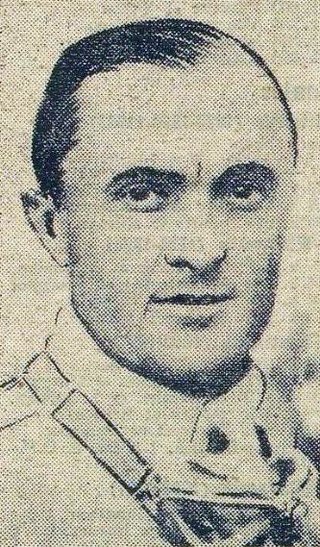
Louis Alexandre Chiron was a Monégasque racing driver who competed in rallies, sports car races, and Grands Prix.

The Coppa Acerbo was an automobile race held in Italy, named after Tito Acerbo, the brother of Giacomo Acerbo, a prominent fascist politician. Following Italy's defeat in World War II, and the consequent demise of fascism, the race was renamed the Circuito di Pescara, and in some years was also referred to as the Pescara Grand Prix and 12 Hours of Pescara. The race was run between 1924 and 1961 and over the years was held to a variety of vehicle class regulations and durations. In 1957 the Pescara Grand Prix formed a round of the Formula One World Championship, a race which still holds the record as having the longest circuit length ever used for a Championship event.

The 1936 Grand Prix season was the third year of the 750 kg Formula. The next iteration of the Mercedes-Benz did not prove successful and the team withdrew during the season to instead prepare for the next one. It therefore fell to the resurgent Auto Union team to dominate the racing. In particular, it was their young, new superstar, Bernd Rosemeyer, who mastered the tricky car and who showed superlative skill in wet conditions. Rosemeyer easily won this season's European Championship by winning three of the four Grands Prix.

The 1937 24 Hours of Le Mans was the 14th Grand Prix of Endurance. It took place at the Circuit de la Sarthe on 19 and 20 June 1937. The race was won by Jean-Pierre Wimille and Robert Benoist in Roger Labric's works-supported Bugatti team, in one of the streamlined new Type 57G cars, at a record pace and exceeding 2000 miles in the race for the first time.

The 1932 24 Hours of Le Mans was the 10th Grand Prix of Endurance that took place at the Circuit de la Sarthe on 18 and 19 June 1932. A significant year for the Automobile Club de l'Ouest (ACO) with the biggest changes to the circuit in the race's history. A new section bypassing Pontlieue suburb was built starting with a long right turn after the pits, going over a hill then down to the Esses, a left-right combination, before rejoining the Hunaudières straight at the new right-hand corner of Tertre Rouge. This shortened the track by almost 3 km down to 13.491 km (8.383 mi).

The 1935 Grand Prix season was the second year of the new 750 kg Formula. The success of the previous year encouraged the AIACR to reinitiate the European Championship. It was composed of the seven national Grands Prix and was won by Rudolf Caracciola, driving for the Mercedes-Benz team. The team dominated the season winning five of those Grand Épreuves, as well as four of the other major races of the season. However, in one of the great motor-races in sporting history, Tazio Nuvolari in a Scuderia Ferrari Alfa Romeo beat the combined numbers of the German teams in their home Grand Prix. The season also saw the arrival on the international stage of the bright young talent Bernd Rosemeyer in the Auto Union team.

The 1931 Grand Prix season was a watershed year, with the advent of the AIACR European Championship. After several years of Grand Prix racing in the doldrums with little technical development, 1931 saw new models come from all three main manufacturers: Bugatti, Maserati and Alfa Romeo.

The 1939 Swiss Grand Prix was a motor race held at Bremgarten on 20 August 1939.

The 1932 Grand Prix season marked the second year of the AIACR European Championship. It saw the debut of Alfa Romeo's sensational new Tipo B and with it, Tazio Nuvolari won the Championship driving for the Alfa Corse works team. The 40-year old Nuvolari won two of the three rounds and was second in the other. Still running to a Formula Libre rules for the cars, the regulations were revised to set the races to be between five and ten hours. However, all three national committees ran their races to the minimum time-limit.

The 1933 Grand Prix season was an intermediate year, as it would be the last season for the current AIACR regulations before a new weight-formula was introduced in 1934. As such, the European Championship was not held and the manufacturers held back on further developments of their existing models. Alfa Romeo, following an Italian government financial bailout and like Mercedes-Benz the previous year, had shut down its Alfa Corse works team. Scuderia Ferrari, their regular customer team took up the role of racing Alfa Romeos and a number of ex-works drivers moved across to join their ranks. They were not allowed, however, to buy the impressive Tipo B that had been so dominant in the previous season.
The 1934 Grand Prix season saw the advent of the new 750 kg Formula. In an effort to curb the danger of rising speeds, the AIACR imposed this upper weight limit that effectively outlawed the large capacity engines. The incumbent manufacturers Alfa Romeo, Maserati and Bugatti had been preparing their new models with varying success – the best of which was the Alfa Romeo Tipo B. However, it was the state-sponsored arrival of the two German teams, Mercedes-Benz and Auto Union, and their innovative and progressive cars that ignited a new, exciting era of motor racing.
The 1925 Grand Prix season was the first year for the new AIACR World Manufacturers' Championship season. The championship was won by Alfa Romeo, with its P2 model.

The 1926 Grand Prix season was the second AIACR World Manufacturers' Championship season and the first running to new 1.5-litre regulations. The championship was won by Bugatti and its Type 35 was the dominant car of the year.

The 1928 Grand Prix season saw the Monegasque driver Louis Chiron, and his Bugatti, take seven Grand Prix victories.

The 1922 Grand Prix season had several notable events during the year. The AIACR governing body brought in a 2-litre formula for Grand Prix. French companies brought out straight-8 engines for their cars but it was FIAT's 6-cylinder engine that took the trophies. Veteran Felice Nazzaro won the French Grand Prix, held near Strasbourg. It was a tainted victory though, as Nazzaro's nephew was killed when his FIAT's suspension broke in the latter stages of the race. An almost identical accident also happened to team-mate Pietro Bordino, though he was only slightly injured. Pierre de Vizcaya's Bugatti finished second, nearly an hour behind.

The 1923 Grand Prix season was part of a watershed year for motor racing that saw significant advances in motor-racing engineering, design and events. Fiat's chief designer, Guido Fornaca, developed the 805, the first supercharged car to win a Grand Prix. Benz appeared with the first mid-engined racer and, along with Bugatti and Voisin, produced some of the first efforts at aerodynamics on racing cars. With the United States also adopting the 2-litre formula, Harry Miller could use the smaller engine size to design the first single-seater race-car, ideally suited to American oval racing.
The 1929 Grand Prix season was another interim year, where most races were run to Formula Libre rules due to a lack of regulations from the AIACR that would be popular for race organisers and manufacturers. This blurred the line between racing cars and sports cars with both competing in the same races. Bugatti won the major international races, with their drivers Louis Chiron and "W Williams". The Italian Championship proved very competitive, attracting many top drivers. There it was Alfa Romeo, using their 4-year old P2 model that claimed more victories, than their main competition coming from Bugatti and Maserati.

László Hartmann was a Hungarian Grand Prix motor racing driver.

The Tunis Grand Prix or Grand Prix de Tunis was a motor race held in the 1920s and 30s in Tunis, the capital of the African colony of the French protectorate of Tunisia.
The Algerian Grand Prix or Grand Prix d'Alger was a motor race held in the 1920s and 1930s at several coastal road courses in the department of French Algeria.
















